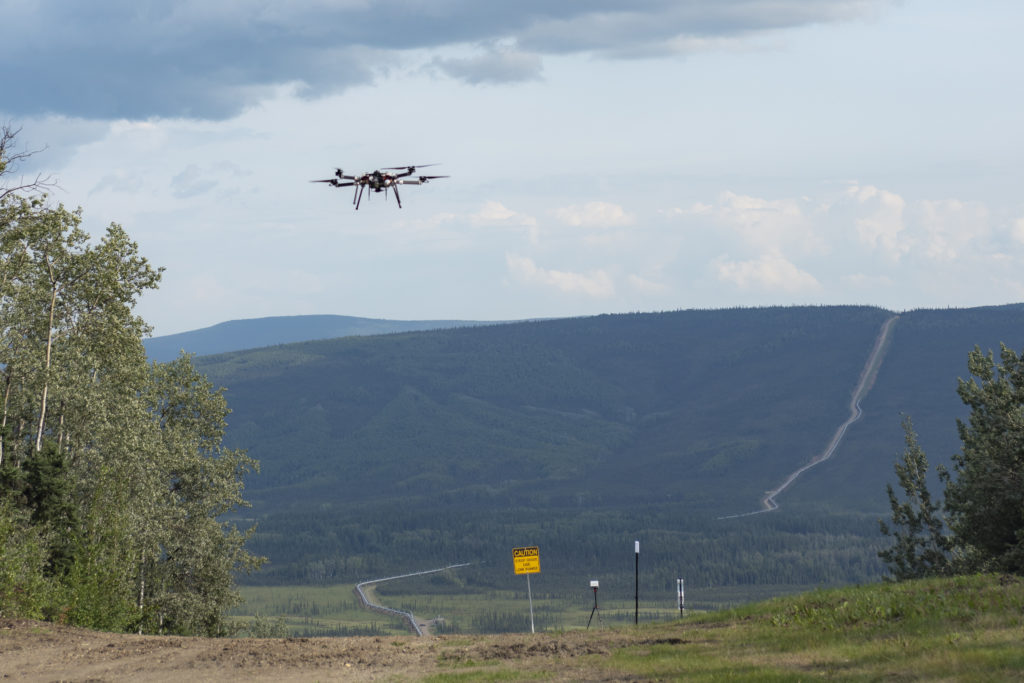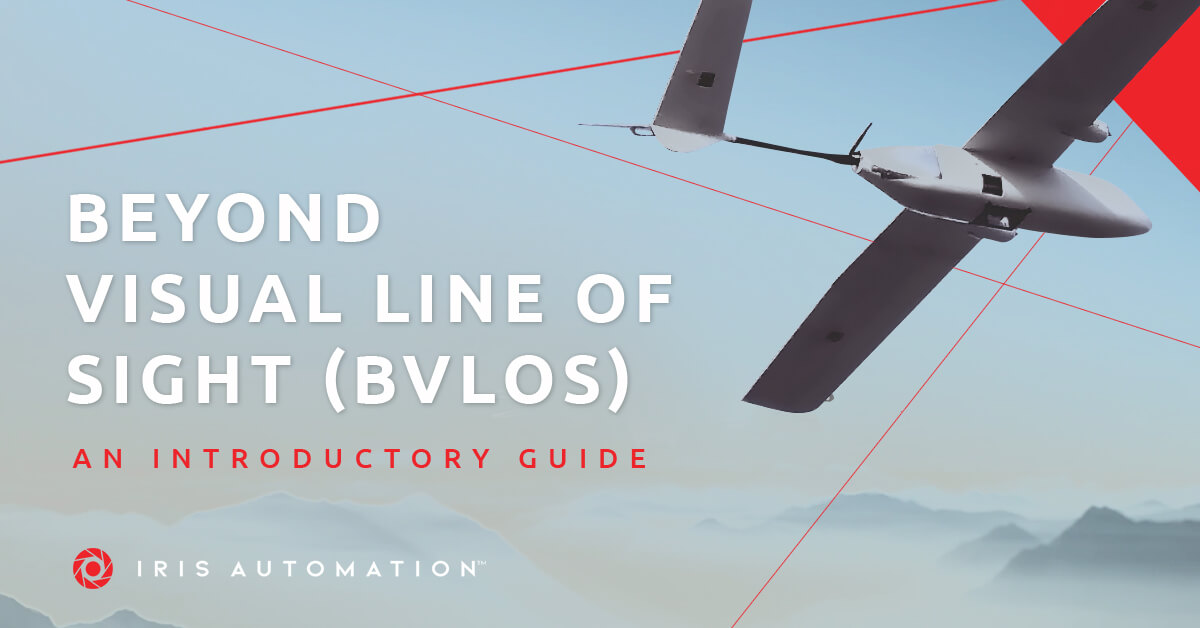What is BVLOS?
BVLOS means Beyond Visual Line of Sight. The FAA (Federal Aviation Administration of the United State’s) regulatory framework around safe drone flight operation relies on the concept of “see-and-avoid,” which is intended to avoid the risk of a mid-air collision between aircraft.
To begin to understand Beyond Visual Line of Sight operations, you have to start with Visual Line of Sight Operations rules.
In manned aviation, this rule is generally fulfilled by having a pilot on-board looking out from inside the aircraft and scanning the horizon for any aircraft that may be on a collision course with their aircraft. In unmanned aviation, however, it is not possible for the pilot to “see” other aircraft heading towards their drone. This is why the current FAA rules dictate that a drone or small UAS operation is conducted “within visual line of sight.” This requirement is currently satisfied in manned-aircraft operations by a pilot on board the manned aircraft looking out from inside the aircraft to see whether other aircraft are on a collision course with the pilot’s own aircraft. However, the person controlling the small UAS cannot see other aircraft in the same manner because they are not inside the aircraft.
This is why the operator of the small UAS must always be capable of maintaining visual line of sight of the small unmanned aircraft they are piloting, unaided by any technology other than prescription glasses or contact lenses. This is called Visual Line of Sight operations (VLOS).
So, what is BVLOS?
BVLOS means “Beyond Visual Line of Sight.” In literal terms, this means flying the aircraft beyond the RPIC, or Remote Pilot in Command’s direct sight of the aircraft. This is generally taken to mean having either a visual observer (VO) to maintain visual observation of the aircraft or having some kind of detect-and-avoid technology on-board to maintain the ability to avoid a mid-air collision.
The framework under which a BVLOS flight can be conducted in the United States is covered under FAA Part 107 – Small Unmanned Aircraft Rule. More specifically, a BVLOS operation may be conducted if a waiver is received from complying with Part 107.31 of this rule (Visual Line of Sight Aircraft Operation). In addition, some operators may also decide to get a waiver from Part 107.33 – Visual Observer rules.
Text of Part 107.31:
§ 107.31 Visual line of sight aircraft operation.
(a) With vision that is unaided by any device other than corrective lenses, the remote pilot in command, the visual observer (if one is used), and the person manipulating the flight control of the small unmanned aircraft system must be able to see the unmanned aircraft throughout the entire flight in order to:
(1) Know the unmanned aircraft’s location;
(2) Determine the unmanned aircraft’s attitude, altitude, and direction of flight;
(3) Observe the airspace for other air traffic or hazards; and
(4) Determine that the unmanned aircraft does not endanger the life or property of another.
(b) Throughout the entire flight of the small unmanned aircraft, the ability described in paragraph (a) of this section must be exercised by either:
(1) The remote pilot in command and the person manipulating the flight controls of the small unmanned aircraft system; or
(2) A visual observer.
Text of Part 107.33:
§ 107.33 Visual observer.
If a visual observer is used during the aircraft operation, all of the following requirements must be met:
(a) The remote pilot in command, the person manipulating the flight controls of the small unmanned aircraft system, and the visual observer must maintain effective communication with each other at all times.
(b) The remote pilot in command must ensure that the visual observer is able to see the unmanned aircraft in the manner specified in § 107.31.
(c) The remote pilot in command, the person manipulating the flight controls of the small unmanned aircraft system, and the visual observer must coordinate to do the following:
(1) Scan the airspace where the small unmanned aircraft is operating for any potential collision hazard; and
(2) Maintain awareness of the position of the small unmanned aircraft through direct visual observation.

So, what does it mean to fly BVLOS?
In the BVLOS world, you would be able to fly an unmanned aircraft without having to maintain sight of it at all times. You can achieve this by either using a visual observer, having an appropriate technology, or following certain actions or procedures that minimize the risk of a mid-air collision.
Part of this process involves getting a waiver for complying with Part 107.31. The FAA has a list of questions typically asked that help them determine if you have the right procedures, risk mitigation, and technology to help avoid mid-air collisions. These questions are broadly based on the following topics:
1. Describe how the Remote Pilot in Command (RPIC) will be able to continuously know and determine the position, altitude, attitude, and movement of their small unmanned aircraft (sUA) or drone and ensure the sUA or drone remains in the area of intended operation without exceeding the performance capabilities of the command and control link.
2. Describe how the RPIC will avoid other aircraft, flying over/into people on the ground, and ground-based structures and obstacles at all times.
3. Describe how the visual conspicuity of the sUA or drone will be increased to be seen at a distance of at least 3 statute miles (mi).
4. Describe how the RPIC is alerted of a degraded sUA or drone function.
5. What procedure will be followed to ensure the required persons participating in the operation have relevant knowledge of all aspects of operating a sUA or drone that is not in visual line of sight of the RPIC?
6. Describe how the RPIC will operate the sUA or drone within the weather requirements while en route.
7. Describe the emitters and command and control link used in the sUA or drone.
Having a Part 107.31 waiver doesn’t mean you can fly an aircraft without any form of visual observation – in fact most Part 107.31 waivers are granted with operators having visual observers (VO) maintaining sight of the aircraft. Depending on the distance flown by the aircraft in a BVLOS operation, a waiver from Part 107.33 may also be needed to account for communication latency between the VO and the RPIC (e.g. if you have the VO in a chase car following the aircraft or daisy-chaining VO’s):
“Waiver from 107.33 Visual Observer 1. Describe how you will account for the communication latency between the visual observer(s) (VO) and the Remote Pilot in Command (RPIC).”
So – in general – you can fly BVLOS if you:
1. Always know the position, altitude, attitude, and movement of your drone/sUA and ensure the sUA or drone remains in the area of intended operation without exceeding the performance capabilities of the command and control (C2) link
2. Are able to avoid other aircraft, flying over/into people on the ground, and ground-based structures and obstacles at all times
3. Your drone can be seen from at least 3 miles away
4. Can be alerted immediately if your drone is degraded or functioning incorrectly
5. All the members of your team involved in the operation have relevant knowledge of all aspects of operating a sUA or drone (and not just your RPIC and VO’s)
6. Be able to comply with weather conditions/requirements during flight (especially with fluctuating weather conditions)
7. Have a strong C2 link
8. Are able to account for any latency in communication between VO’s and the RPIC
Some of these requirements can be fulfilled with a visual observer, but most can also be fulfilled with a detect-and-avoid system (particularly around point #1, and point #8).
More broadly, using detect-and-avoid technology helps mitigate risks such as losing your C2 link for periods of flight, and for avoiding mid-air collisions with other aircraft, ground-based obstacles and such. You may also not need a VO, although most organizations applying for Part 107.31 waivers obtain Part 107.33 waivers as well.
Sources:
https://www.faa.gov/uas/media/Part_107_Summary.pdf
https://www.law.cornell.edu/cfr/text/14/107.31
https://www.law.cornell.edu/cfr/text/14/107.35
https://www.faa.gov/uas/commercial_operators/part_107_waivers/
https://www.faa.gov/uas/resources/events_calendar/archive/2019_uas_symposium/media/How_To_Get_Approval_to_Fly_BVLOS-Part_107.pdf![]()
https://ntrs.nasa.gov/archive/nasa/casi.ntrs.nasa.gov/20190025701.pdf![]()

